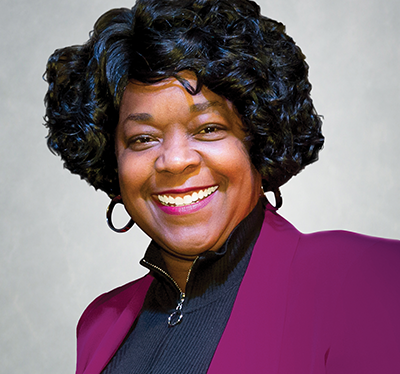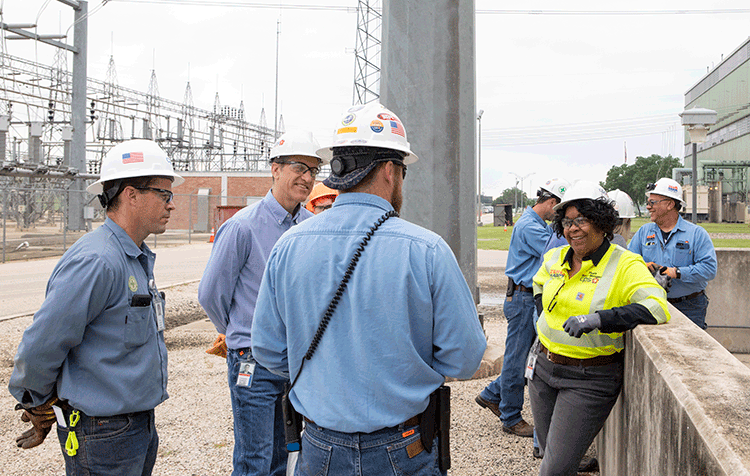2020 CEOs Who 'Get It'


Paula Gold-Williams
President and CEO
CPS Energy
San Antonio
CPS Energy is the nation’s largest municipally owned electric and gas company. Leading with a people-first culture, CPS has been providing safe and secure, affordable, reliable, resilient, and environmentally responsible power to more than 1 million customers and nearly 2 million Texans since 1860. The company has nearly 3,200 employees.

Why is safety a core value at your organization?
We are a community-owned organization that remains focused on keeping people first. Safety is therefore a top priority and core value at CPS Energy. We in turn strive for a consistent “zero harm” environment, whereby the health, safety and overall well-being of all our employees is fundamental to the success of our business.
Companywide, we have further refreshed our focus on our customers and communities that complements our people-first philosophy. This philosophy is as simple as it sounds – we must unselfishly do the right thing for the right reason, especially to keep everyone safe.
Describe your personal journey to becoming a CEO who “gets it.” What experiences or lessons brought you to where you are now?
I am very proud to be a product of San Antonio! I was born here and am “powered” here. This is where my career journey started in accounting and where I gained experience in various industries. Through many challenging opportunities, I have focused increasingly on people. This is true because throughout my career, particularly at CPS Energy, I have learned that it is a true privilege to lead and to protect others from harm. I am a big believer in just saying “yes” and making sure that you say it a lot. Take all opportunities into consideration – don’t just envision being successful. Think through where taking a risk could lead to failure and then think deeper about the important steps that can prevent problems, while simultaneously ensuring success.
Opportunities will come, but our motivations cannot be primarily about job titles and delusions of grandeur. More importantly, it is about the substance and value that you bring to your role. That is what begets opportunities to work and live, both securely and safely. We are an organization with lots of different professions. They include skilled/craft workers, accountants, engineers, energy advisers and the list goes on. These days, all of us must operate within a landscape of ambiguity and gray, which can make people feel uncomfortable. Every day, I challenge my team members to be OK with ambiguity. They need to be able to respond to needed changes in their environment quickly and methodically. One of my relatives often says, “Change is inevitable; resistance to change is futile.” So the more you can keep accepting reality shifts and use the new momentum to invigorate your creativity, the more you and your organization will benefit. I think this is an important reminder when it comes to safety, as our surroundings and day-to-day activities can change at any given moment.
What is the biggest obstacle to safety at your organization, and how do you work to overcome it?
Our biggest safety obstacle to overcome is cyclical complacency. CPS Energy has been in the utility business for nearly 160 years, with a rich history of employees staying in the organization well beyond their retirement eligibility. Naturally, we may sometimes get caught up in our day-to-day routine. Unconsciously, we can take for granted our surroundings and the people we work with. It can, in turn, be a challenge for some to be present and in the moment if some tasks are repetitive. Between 2010 and 2017, we decreased our recordable injury rate from 3.06 to 0.54, achieving a top-decile industry ranking. Over an eight-year period, we have successfully reduced the number of incidents and accidents by over 82%.
Unfortunately, though, we have seen an increase over the past of couple years in our injuries. We learned that what got us to excellent performance will not keep us there. As a result, we remain committed to refreshing our safety focus comprehensively throughout each year. To mitigate and prevent further reoccurrence, we have invested countless hours into preventive measures, with the understanding that being proactive is a superior option to only being reactive. A few strategies we are implementing to combat complacency include a laser-focus view on our safety culture. This ongoing process continues to transform our enterprise as we create a new grassroots safety team, one continually focused on culture. We hold companywide “safety standups” after every major holiday to regroup and refocus as a team and to review preventive safety reminders.
Additionally, before every job, and even every meeting, regardless of size, we start with a “safety tailboard” to identify the nearest exit routes, points of contact in the event of an emergency, hazards and other worksite considerations. New approaches also include executive sponsorship and participation in safety messaging by reiterating our safety vision and values through campaigns such as “Stop the Job” videos. Collectively, our efforts are continually designed to empower anyone and everyone to say something if they see a concern. Our goal is to avoid complacency. Although we were very successful at driving our recordable injury rate down, maintaining that level of excellence brings a whole new set of challenges. A primary challenge is to resist the tendency of slipping back into a state of routine combined with distracted complacency. We therefore continually look for ways to refresh and reinforce our “zero harm” approach to safety.
How do you instill a sense of safety in employees on an ongoing basis?
CPS Energy is a 24/7/365 operation, and safety is paramount to what we do. Through our people-first philosophy and “zero harm” approach, we have adopted “Core Safety Covenants” that facilitate a culture of trust that empower people to make safe and secure choices. Some covenants reinforce that “each employee understands that working safe is a way of life” and “each leader owns the safety performance of the employees, contractors, vendors, and visitors for which he or she is connected to.” Our leaders set the safety expectation, and our employees are empowered to fulfill that commitment.
How does your organization measure safety? What are the leading indicators that show you how safe your organization is, and where do you see room for improvement?
Our “zero harm” culture means that every decision is made with safety at the forefront. Our expectation is that this concept is integrated into the work goals of every employee and contractor who works for CPS Energy. Metrics are created based on past performance, benchmarking and continuous improvement. We vow to not be satisfied until “zero harm” is achieved and maintained. Year after year, safety has been included on our Balanced Scorecard as an important corporate metric. A few years back, the primary safety metric was the recordable injury rate. To ensure we were not inherently discouraging the reporting of accidents, last year we added and prioritized the OSHA severity rate above the RIR. The severity rate is a measure of the number of lost work days experienced per 100 workers to maintain a commitment to safety excellence. As of July, we had exceeded our severity performance threshold; however, we already are leaning into new program enhancements that favorably change our safety landscape. Additional activities we are working toward to strengthen our “zero harm” goals include increased training and certifications for safety professionals and enhanced partnerships with internal customers.
What role does off-the-job safety play in your organization’s overall safety program? What types of off-the-job safety and health programs does your organization offer to employees?
A major objective of our wellness program is to encourage an awareness of health and well-being and the importance of a healthy lifestyle inside and outside of the workplace. Some wellness incentives include:
- Reduced fees for gym memberships in which CPS Energy and the local YMCA subsidize a portion of the membership cost
- Free annual flu shots for employees at all CPS Energy locations
- Wellness grants to promote increased physical activity, in which groups of employees are eligible to receive a reimbursement for the cost of registration fees and certain equipment
- The Healthy Café Discount Program, in which employees receive a price reduction when they purchase healthy food options in the company’s cafeterias, including special healthy entrees that are promoted each week
- Activities to promote increased physical activity, such as the “Sit for 60, Move for 3” program and our main office indoor walking path that encourages employees with desk jobs to move more throughout the day
- Presentations on the importance of healthy eating habits and hydration for our field workers who spend most of their workday outdoors, often in extreme weather conditions
These are just some of the things to highlight. We remain committed to future program improvements because it will be the difference in protecting everyone in any way we can.
Post a comment to this article
Safety+Health welcomes comments that promote respectful dialogue. Please stay on topic. Comments that contain personal attacks, profanity or abusive language – or those aggressively promoting products or services – will be removed. We reserve the right to determine which comments violate our comment policy. (Anonymous comments are welcome; merely skip the “name” field in the comment box. An email address is required but will not be included with your comment.)


